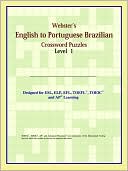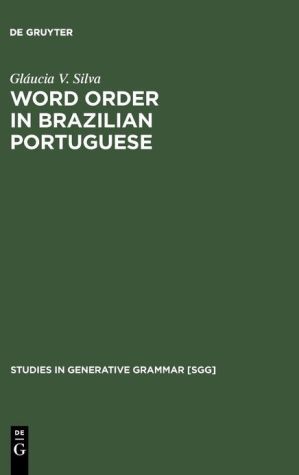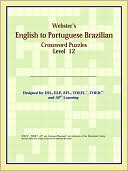Talking Brazilian: A Brazilian Portuguese Pronunciation Workbook
This book and its two companion CDs provide a complete guide to the pronunciation of Brazilian Portuguese. Devised to meet the particular needs of native English speakers, Talking Brazilian may be used by independent students seeking to improve their pronunciation skills as well as by students in traditional classrooms and language labs. The book takes a practical approach in its numerous exercises, and the CDs offer exercises and dialogues recorded by native speakers of Brazilian...
Search in google:
This book and its two companion CDs provide a complete guide to the pronunciation of Brazilian Portuguese. Devised to meet the particular needs of native English speakers, Talking Brazilian may be used by independent students seeking to improve their pronunciation skills as well as by students in traditional classrooms and language labs. The book takes a practical approach in its numerous exercises, and the CDs offer exercises and dialogues recorded by native speakers of Brazilian Portuguese.Author Biography: Mário A. Perini is associate professor of linguistics at Pontifíca Universidade Católica, Minas Gerais, Brazil. He has taught linguistics and Portuguese at major Brazilian universities for more than thirty years and as visiting professor has taught Portuguese as a foreign language at several universities in the United States. Yale Language Series
Talking Brazilian\ A Brazilian Portuguese Pronunciation Workbook \ \ By Mario A. Perini \ Yale University Press\ Copyright © 2004 Yale University\ All right reserved.\ ISBN: 0-300-10021-3 \ \ \ \ Introduction\ To the Teacher \ Whoever teaches foreign languages knows that there are no magical formulas. Written exercises, oral practice, audiovisual and audio-oral resources, structural drills, communicative approaches-all these are useful, but none provides "the solution." In general, teachers make use of each method as they feel it to be appropriate. No substitute has been devised for the resourceful teacher seconded by the intelligent, hard-working student.\ Is there a methodology that harmonizes perfectly with the current linguistic theories? My position, amply borne out by classroom experience, can be expressed in Anna Ciliberti's words: "The best methodology, the one that yields the most satisfactory results, is always a mixed methodology, difficult to define because its success dwells in the details, in the dosage, in flexibility ...-features that are difficult to generalize" (Manuale di Glottodidattica [Florence: La Nuova Italia Editrice, 1994], 83; my translation). This does not mean that theory is irrelevant, just that its use in our activities must always be subordinated to the goals of language teaching. Ultimately every procedure will stand or fall according to the excellence of its results.\ Since language teaching is essentially such a complex activity, teachers will do well to have at hand a variety of tools and to learn to employ them all. This book provides one such tool, aimed at perfecting students' pronunciation of Portuguese by means of exercises and drills\ Principles Underlying the Approach\ A pronunciation workbook Some authors question the utility of a pronunciation workbook, often because they misunderstand the claims of Communicative Language Teaching and related methodologies, which are in fact perfectly compatible with a focus on phonological and phonetic accuracy. As an auxiliary resource, a pronunciation workbook is a very useful tool in language teaching, particularly at the early stages. Pronunciation skills are basically automatic; that is, pronunciation is one of those things that you do not really know until you forget about them. The acquisition of correct Pronunciation-especially by adults-requires a great deal of practice, and that is what the exercises in this book provide.\ The contrastive approach The approach adopted here may be defined as contrastive-another of the formulas once thought to provide a basis for "the solution" and later, just as wrongly, rejected by some as useless. Contrary to what some authors apparently believe, contrastive analysis is not connected in any essential way to behaviorist theories in linguistics or in psychology. It is neutral as to theoretical approach and assumes simply that a main source of the difficulties an adult encounters when learning a new language is interference between the features of that language and comparable features of his or her native language. For instance, we can predict that an English speaker will have some trouble with the gender of nouns in Portuguese (e.g., mesa 'table' is feminine, whereas banco 'bench' is masculine); with the pronunciation of nasal vowels; and with the structure of the (colloquial) relative clause o casaco que eu viajei com ele 'the coat I traveled with.' Such potential points of difficulty are identified by means of a contrastive analysis of the two languages.\ For all its relevance, contrastive analysis does not solve all problems. Not all points in which the two languages differ will automatically become learning problems, nor are contrastive differences the only source of problems. The task of learning pronunciation is complex, and we should never put our trust blindly on any one resource. There is nothing simple about language learning and teaching.\ The contrastive analysis of the native language with the language being learned is, however, one of the resources that authors and teachers must use when trying to devise more efficient language courses. And exercises and drills are indispensable in enabling adult students (as opposed to children up to about twelve) to develop fluent speech habits in a foreign language.\ Differences among languages Some authors hold that foreign-language learners tend to concentrate on the aspects of the language that are essential for communication while neglecting the aspects that are of low utility. Apart from the vexed question of ascertaining with any reliability the utility of each element of a language, I think such an opinion is disproved in most cases. Rather, classroom experience shows that students are very often bogged down by those features of the foreign language that, regardless of their communicative utility, differ most markedly from related features in the students' native language. If it were otherwise, there would be no explanation for the trouble that native Portuguese speakers have in learning to aspirate initial voiceless consonants or to pronounce correctly the r's in sequences like Sorority Row, nor their ease in pronouncing the z in zebra-which is difficult for speakers of Spanish, a language that lacks the z sound. Such contrastive differences loom particularly large in the area of pronunciation.\ Fossilization A serious and often neglected aspect of language learning is that perfect pronunciation is not essential to communication; it is possible to speak and be understood in a foreign language even if one's pronunciation only approximates a native speaker's. As soon as basic communication is achieved, poor pronunciation habits may "fossilize": "The learner stops at a certain level of competence, sufficient for the needs of communication, and does not progress any more." Ciliberti explains further that fossilization "seems to be caused by the fact that the [learner] does not manage to analyze the incoming data, compare them with his own production, evaluate the differences, and finally formulate new hypotheses" (Manuale, 46, 174).\ Fossilization helps account for the inability of many adults to acquire a good pronunciation of a foreign language. Doing serious work on pronunciation at the early stages of learning is important, therefore. If fossilization is inevitable, teachers must at least work with the students, and students must strive, to achieve pronunciation as close to native as possible.\ Overall Organization\ OVERVIEW\ The sounds The present workbook consists mainly of exercises. Complete descriptions and explanations of all sounds in Portuguese and their orthographic representations are found in chapters 2-6 of my Modern Portuguese: A Reference Grammar (New Haven: Yale University Press, 2002). Although Modern Portuguese may be consulted as a reference, this workbook can be used independently. All crucial information is provided in the workbook or in the recording.\ A systematic approach In this workbook the study of Brazilian Portuguese pronunciation is approached in a way that may be described as progressive and contrastive. Instead of beginning with complete sentences, that is, with all the phonetic and phonological complexity of normal utterances, I have classified every sound of the language, taking into account their clusterings and distribution in words and sentences, and introduced them according to the degree of difficulty they present to the English-speaking student.\ The intersection of English and Portuguese Students will begin practicing pronunciation with words composed of sounds that are virtually identical in English and Portuguese. In the first words, the sounds are placed in phonological environments as similar as possible to the ones in which they occur in English. New environments are gradually introduced. Eventually the student is learning Portuguese sounds that have no correlates in English.\ Vowel and semivowel pronunciation For unknown reasons, some sound sequences that are present in both English and Portuguese cause pronunciation problems for many English speakers. Let me mention in particular certain vowel and semivowel sequences like the ones found in maioria 'majority' and continuar 'to continue.' I include exercises to practice these.\ DESIGN OF THE LESSONS\ Each sound is the subject of special drills that emphasize listening and speaking in turn. The systematic approach enables students to build adequate pronunciation without overloading their attention with too many unknown sounds at once. The accompanying CD provides models of native speech to be imitated. It includes all Portuguese words and sentences given in the text. The thirty-two lessons provide a complete course in the pronunciation of Brazilian Portuguese.\ Lessons 1-3 focus on words made up of vowels and consonants identical in English and Portuguese. The exercises present them in phonological environments that match their distribution in English.\ Lesson 4 introduces the vowel [u], which is similar, but not identical to, English u in rule and thus requires special attention.\ Lesson 5 presents the vowel [[epsilon]], which is identical to English e in less but appears in different environments. In Portuguese it may, for instance, appear at the end of a word. After completing this lesson, students will have been introduced to all sounds of the language, as well as all sound sequences that may be difficult to produce.\ Lessons 6-32 deal with intonation, stress, rhythm, and sound changes in context-the rest of the elements that, once learned, make speakers sound like native Brazilians.\ In certain cases Portuguese utilizes phonological oppositions that are absent in English, and these are treated in special drills. An example is the opposition between oral versus nasal vowels, for which I provide exercises based on the perception and production of minimal pairs (mudo [u] / mundo [u], pau [aw] / pao [AW], vi [i] / vim [i], etc.).\ LEARNING THE SOUNDS\ At the head of each lesson is a list of the sounds or s introduced. The sounds are given in phonetic transcription and then briefly described. I compare them with English sounds where applicable. The descriptions, in boxes marked with a pushpin, are sometimes taken more or less verbatim from Modern Portuguese.\ The explanations are to be taken only as memory aids. Students should work primarily by imitating the models provided on the CDs and by the teacher. No description or explanation can replace aural perception and memorization. Still, explanations can be useful given the difficulties students may experience in perceiving phonetic differences between the languages (the "blind spots" of aural perception)-as when an English-speaking student fails to perceive the difference between Portuguese oral and nasal vowels and thus cannot tell vi '(I) saw' from vim '(I) came,' or when the student pronounces the Portuguese dei (with a dental consonant) as identical to the English day (with an alveolar consonant). Here the role of the teacher is crucial, for students are often unable to overcome such deficiencies by themselves.\ After the sound list, I give some words or short phrases to be pronounced in isolation following the recorded models. With each word or phrase is a phonetic transcription plus a gloss (sometimes very approximate). Where appropriate, I provide minimal pairs to help students perceive sound differences that do not occur in English.\ Only one phonetic transcription is given for each form, but in some cases other pronunciations are also possible and equally acceptable. For instance, reis 'kings' and res 'head of cattle' are assigned different pronunciations (['he:js] and ['he:s], respectively); but for many speakers they are homophonous, both being pronounced ['he:js]. These alternatives are not given in the material included here; some of them are described in chapters 2-4 of Modern Portuguese.\ Every lesson includes a set of sentences and phrases that provide models of intonation patterns and the way words are joined in normal speech, allowing students to practice fluency with longer stretches of discourse. The repetition of ready-made sentences, carefully planned to include only sounds already studied, has the advantage of freeing students' attention to concentrate on the pronunciation, including intonation, following the recorded models.\ In the first three lessons, I include some additional phrases and sentences for advanced students who already have some proficiency but still need to work on their pronunciation. Beginners should skip over all the exercises marked "For Advanced Students."\ LEARNING THE DIALOGUES\ To take the practice in normal speech one step further, I also provide, starting with Lesson 15, some short dialogues, to be memorized and performed as little plays by pairs of students. At that stage the student will probably be able to understand these dialogues (perhaps with the help of the teacher). A student should never learn by rote a text he or she does not fully understand. Learning a series of sounds by themselves leads nowhere.\ Memorizing texts may be viewed by some as an old-fashioned activity, but in my opinion, it is very useful in acquiring good pronunciation of a foreign language. Memorization frees the mind from the burden of building the utterance and makes it easier for the student to focus on details of pronunciation-in particular, intonation, rhythm, and the fluent, natural linking of words in sentences.\ All texts are recorded, providing a model to be followed. The first texts are planned to avoid some of the more difficult sounds and sound combinations, such as nasal vowels and diphthongs, triphthongs, and proparaoxytones, as well as very long words. These difficulties are gradually included in later texts, following their introduction in the lessons.\ The texts are written in a rather colloquial register, to sound natural when spoken. In this I follow the general practice of modern Brazilian playwrights.\ Some of the sentences in the lessons are used only in the spoken language (see chapter 1 of Modern Portuguese for the difference between spoken and written usage in Brazil). And if some of the sentences sound slightly funny, please remember that they were composed under severe phonological limitations: each sentence contains only sounds studied in previous lessons. The same applies to the selection of isolated words, so in a few cases I had to depart from the criterion of selecting high-frequency items in order to attend to the needs of phonological illustration.\ \ Continues...\ \ \ \ Excerpted from Talking Brazilian by Mario A. Perini Copyright © 2004 by Yale University. Excerpted by permission.\ All rights reserved. No part of this excerpt may be reproduced or reprinted without permission in writing from the publisher.\ Excerpts are provided by Dial-A-Book Inc. solely for the personal use of visitors to this web site. \ \







